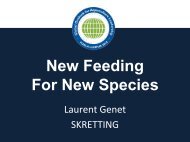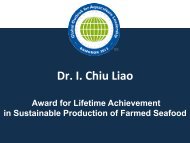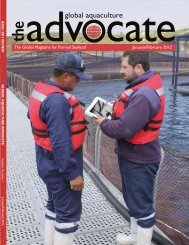May/June 2010 - Global Aquaculture Alliance
May/June 2010 - Global Aquaculture Alliance
May/June 2010 - Global Aquaculture Alliance
You also want an ePaper? Increase the reach of your titles
YUMPU automatically turns print PDFs into web optimized ePapers that Google loves.
At larger farms, water quality is maintained by regular<br />
water exchange.<br />
volume is changed every 10-15 days to maintain water quality.<br />
The ponds have low dikes and so may flood during the monsoon<br />
season, but striped catfish, unlike other farmed species, remain<br />
in flooded ponds.<br />
Laitram Machinery didn’t just invent “the shrimp peeling machine” more than<br />
six decades ago, they invented the automated shrimp processing industry. And<br />
they continue to bring innovation to the industry - increasing yield and quality,<br />
saving energy, and providing worldwide service and support, year after year.<br />
www.laitrammachinery.com TEL 504-733-6000 lm.sales@laitram.com<br />
66 <strong>May</strong>/<strong>June</strong> <strong>2010</strong> global aquaculture advocate<br />
Nursed 50-g fingerlings are stocked at 4-5/m 2 and fed commercial<br />
pelleted feed for feed-conversion ratios of 1.7 to 1.8. The<br />
average production is 60-70 mt/ha of 1.0- to 1.2-kg fish in 10<br />
months, including limited growth during the cool season. Production<br />
on small-scale farms is typically about 40 mt/ha.<br />
Most smaller farms do not exchange water and give fish<br />
poorer-quality feed from cottage factories or farm-made feeds<br />
with low stability. These two factors cause poor water quality that<br />
can lead to lesser-quality fish suitable only for the local market.<br />
Export Potential<br />
Large-scale striped catfish farms must export fish to survive<br />
in the future because of unstable local market prices and the<br />
large investment required to lease land for 10 years and construct<br />
ponds and deep tube wells. However, the 15 to 20% return on<br />
investment with current prices is attractive.<br />
Striped catfish production in Vietnam, the current major<br />
exporter of the species, is much higher at 300-400 mt/ha. But<br />
there the ponds are 4 to 6 m deep, and the water is changed<br />
much more frequently, entailing a higher unit production cost<br />
than that in Bangladesh. Furthermore, both land rental and<br />
labor costs are lower in Bangladesh than in Vietnam.<br />
The flesh color of catfish farmed in Bangladesh is yellowish,<br />
so the fish could only be marketed in Eastern Europe, but trials<br />
are under way to see if flesh quality could be improved by reducing<br />
the maize content of the feed. A fish-processing plant also<br />
needs to be built in Mymensingh, as current plants, which process<br />
shrimp, are mainly located in the south of the country.<br />
Put more than six decades of Laitram<br />
processing innovation in your plant.<br />
Delivering Certainty<br />
Today, more than ever, seafood<br />
buyers want certainty.<br />
They want products that are<br />
responsibly grown and processed.<br />
They want evidence that suppliers<br />
are adhering to rigorous production<br />
standards—right back to the farm<br />
or the shing vessel.<br />
That means transparent traceability<br />
throughout the entire supply chain.<br />
At Trace Register, we are proud of<br />
the fact that the world’s leading<br />
aquaculture program, Best<br />
<strong>Aquaculture</strong> Practices, uses the<br />
Trace Register® system to deliver<br />
that traceability.<br />
Let us show you why.<br />
Contact us at:<br />
sales@ traceregister.com<br />
+1 (206) 621.1601<br />
www.traceregister.com





